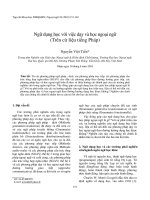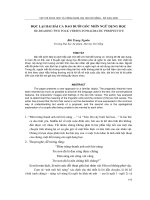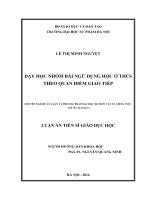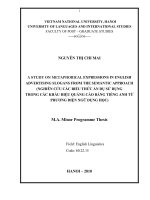Mau 6 - Script ngu nghia ngu dung hoc week 11
Bạn đang xem bản rút gọn của tài liệu. Xem và tải ngay bản đầy đủ của tài liệu tại đây (207.74 KB, 5 trang )
BÀI GIẢNG DẠNG VĂN BẢN (SCRIPT)
Môn học: SEMANTICS AND PRAGMATICS
Week 1
Unit 1 and Unit 2: Definitions of Semantics and Pragmatics - Sentences, Utterances, and
Propositions
Slide
NỘI DUNG
1
Hello again. Welcome to Semantics and Pramatics course. It’s so good to
meet with you here.
2
In week 1, we are going to finish Units 1, 2, 3, 4. We will talk about
definitions of semantics, Sentences, Utterances, and Propositions, Semantic
features, and Semantic/lexical field
3
First we are going to give difinitions of Semantics.
There are different defintions of semantics.
Semantics is generally defined as the study of meaning (Lyons, 1977;
Hurford, Heasley, 1983).
Saeed (2003): “Semantics is the study of the meaning of words and
sentences”.
4
Griffith (2006) defined that: “Semantics is the study of the “toolkit” for
meaning: knowledge encoded in the vocabulary of the language and in its
patterns for building more elaborate meanings, up to the level of sentence
meaning.”
5
From the above definitions, the common words when talking about
semantics are meanings, words, sentences, and relationhips. It can be
summarised that Semantics is the study of the relationships between
linguistic forms and entities in the world; that is, how words literally
connect to things.
In short we can say that Semantics is the study of meanings of words and
sentences.
6
In this part we talk about sentences, utterances and propositions.
We can identify the differences between the two terms “sentence” and
“utterance”. A sentence is a unit of language (an abstract thing, a part of
language itself); a string of words put together by the grammatical rules of a
language. A sentence conveys a meaning. We can see the two sentences
here.
Ex: The man is on the tree.
The students are studying in the lab.
So here we have different words. All the words are linked together
grammatically. We have the subject “the man”, and the verb agrees with the
subject, and “on the tree”
7
Now we continue with sentence meaning. Meanings of a sentence come
from only within the language, independent of context.
Ex:
I love you.
I hate you.
You can understand the meanings of the two sentences based on the
meanings of I, you, love, hate. We do not talk about the context here.
8
Utterance (phát ngôn):
An utterance is also a group of words or a part of speech in between pauses.
An utterance is usually confined to the spoken language. An utterance is
what speakers say or write; you can give the time, date, place of an utterance
An utterance includes: intonation, stress, patterns, gestures
For example
A boy and a girl in the photo were sitting on the railways in the afternoon.
He said, “Do you remember the days when we first met?” The girl replied
“I will never forget that day.” We have intonation, the time and the place=>
they are utterances.
“Do you remember the days when we first met?” and “I will never forget
that day.” are utterances spoken by the boy and the girl. These utterances
include stress, intonation, gestures of a boy and a girl.
9
Here are some characteristics of utterances.
• It is spoken or written as well
• Physical event
• May be grammatical or not
• Can be a phrase “Such a beautiful girl!” “My goodness!”or even a
single word “Wow!” Ohhh!”
• Can be identified by a specific time, at a specific place
• Spoken by a specific person (with particular accent) giọng miền Bắc,
giọng miền Trung, giọng miền Nam.
10
Proposition (mệnh đề nghĩa)
The basic idea/thought of the sentence; events or states; say something
about events/states.
Core sentence meaning, the abstract idea that remains the same in cases.
Examples:
Sharks hunt seals.
Seals are hunted by sharks.
Seals are preys to sharks
=> THE SAME MEANING (3 sentences, same proposition)
11
Propositions, unlike sentences, cannot be said to belong to any
particular language. Sentences indifferent languages can correspond to the
same proposition, if the two sentences are perfect translations of each other.
Example
English I love you
French je t'aime
Japanese わたしは、あなたを愛しています
Watashi wa, anata o aishiteimasu
and Chinese 我爱你
Wǒ ài nǐ
=> same proposition, same meaning
12
You can look at these two persons. Do you think that they really hate each
other. Utterance has propositional and contextual (or interpersonal)
meaning.
13
14
The meaning of an utterance comes from the language, the context & from
features of language (e.g. intonation, stress, gestures). In order to
understand the meaning of an utterance we have to understand the literal
meanings of the words and to consider the context.
Examples of utterance:
Can you open the window?
mother to child (order)
This is an order.
15
Who are they?
They are students. When they say “Is your homework ready?”, what is the
meaning? And here is a teacher. When the teacher says ““Is your homework
ready?”, what is the meaning?
• Is your homework ready?
Student to student: Can I copy it?
Teacher to student: Turn it in.
16
Utterance meaning has to be determined from the context (intentions of
speaker/hearer, their relationship; the time, place, roles)
Sentence meaning (propositions) is independent of context.
17
A sentence can have more than one proposition.
I give you a ring. I give you a phone call or I give you a piece of jewllery in
the form of a circle that you wear on a finger.
Proposition:
only linguistic element, without interpersonal meaning
corresponds roughly to a complete independent thought
18
We can look at other examples.
Harry took out the garbage
Harry took the garbage out.
=>There are 2 sentences, but only one proposition (the same meaning)
John gave Mary a book
Mary was given a book by John
=>There are 2 sentences, but only one proposition
19
20
Now we have more details about propositional meaning (sentence) and
interpersonal meaning (utterance)
Proposition vs. utterance analysis:
“The book is open.” What is the meaning of this utterance?
“The book is open.”
Sentence meaning: The book is in a state of opening. The meaning is from
the meaning of the words in the sentence.
Utterance meaning: You are copying from the book when teacher saw the
book open in the exam room. This is an accusation.
When a student says
“Tom opened the book.”
This is a defense against accusation; the student tries to put blame on
someone else
22
We can look at the diagram. One proposition can be written with different
sentences. A sentence in different contexts can produce different utterances.
You can see the relationship between proposition and sentence, between
sentence and utterance. For an utterance we have time, place, intonation and
accent.
Please complete these .
Put pluses or minuses accordingly.
23
The answers are presented.
24
Can a sentence be true or false?
Is an utterance tied to a particular time and place?
Is a sentence tied to a parlicular time and place?
Can a proposition be said to be in any particular language?
Can an utterance be true or false?
25
This is the end of the first part of week 1. Thank you for you attention. See
you again very soon!
21









